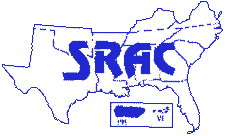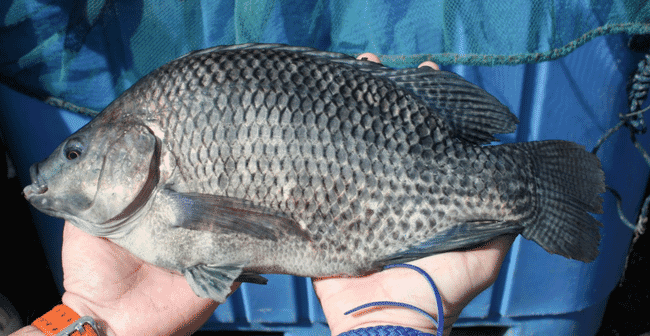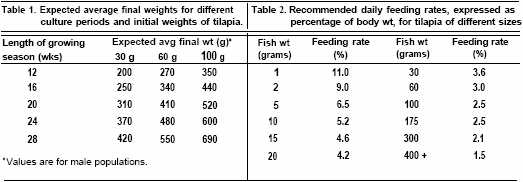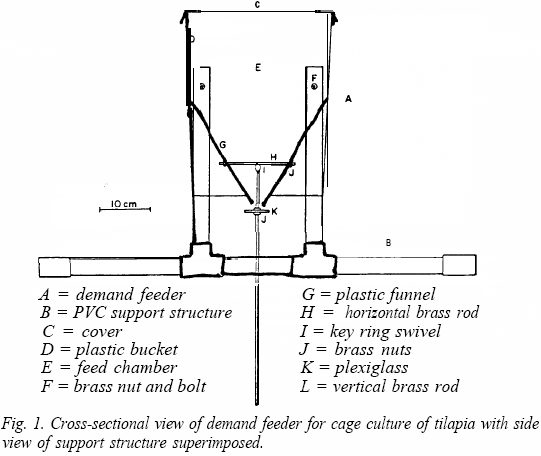Edited by James E Rakocy from the University of the Virgin Islands and Andrew S McGinty, from the University of Puerto Rico, the new book is published by the Southern Regional Agricultural Center and the Texas Aquaculture Extension Service.
It explains how the use of cages / net pens can be applied in existing bodies of water that cannot be drained or seined and would otherwise not be suitable for aquaculture.  These include lakes, large
reservoirs, farm ponds, rivers, cooling
water discharge canals, estuaries
and coastal embayments. In the
southern US, tilapia are among the
most suitable fishes for cage culture.
These include lakes, large
reservoirs, farm ponds, rivers, cooling
water discharge canals, estuaries
and coastal embayments. In the
southern US, tilapia are among the
most suitable fishes for cage culture.
Species selection
The most appropriate species or
strains of tilapia for cage culture are
Oreochromis niloticus (Nile tilapia),
O. aurea (blue tilapia), Florida red
tilapia, Taiwan red tilapia, and
hybrids between these species and
strains. The choice of a species for
culture depends mainly on availability,
legal status, growth rate and
cold tolerance. Many states prohibit
the culture of certain species. Unfortunately, Oreochromis niloticus, which has the
fastest growth rate, is frequently
restricted. The ranking for growth
rate of the remaining species or
strains are Florida red tilapia >
Taiwan red tilapia > O. aurea.
Hybrids of Oreochromis niloticus x Taiwan red
tilapia grow as fast as O. niloticus.
Hybrids of T. aurea x Florida red
tilapia grow at an intermediate rate
between Florida and Taiwan red
tilapia. Cold tolerance, important in
Texas Agricultural Extension
northerly latitudes, is greatest in O.
aurea.

© Hideoyoshi Segovia
Tilapia can be cultured at high densities in mesh cages that maintain free circulation of water. Cage culture offers several important advantages. The breeding cycle of tilapia is disrupted in cages, and therefore mixed-sex populations can be reared in cages without the problems of recruitment and stunting, which are major constraints in pond culture. Eggs fall through the cage bottom or do not develop if they are fertilized. (Reproduction will occur in cages with 1/10-inch mesh or less, which is small enough to retain eggs.) Other cage advantages include:
- flexibility of management
- ease and low cost of harvesting
- close observation of fish feeding response and health
- ease and economical treatment of parasites and diseases
- and relatively low capital investment compared to ponds and raceways.
Some disadvantages are:
- risk of 1oss from poaching or damage to cages from predators or storms
- less tolerance of fish to poor water quality
- dependence on nutritionally-complete diets
- and greater risk of disease outbreaks.
In public waters, cage culture faces many competing interests and its legal status is not well defined. Not all bodies of water offer proper conditions for cage culture.
Design and construction
Both floating surface cages and standing surface cages are used for tilapia culture. Standing cages are tied to stakes driven into the bottom substrate, whereas floating cages require a flotation device to stay at the surface. Flotation can be provided by metal or plastic drums, sealed PVC pipe, or styrofoam. Cages should be constructed from materials that are durable, lightweight and inexpensive, such as galvanized and plastic coated welded wire mesh, plastic netting and nylon netting. Welded wire mesh is durable, rigid, more resistant to biological fouling, and easier to clean than flexible material, but is relatively heavy and cumbersome. Plastic netting is durable, semi-rigid, lightweight and less expensive than wire mesh. Cages made of nylon netting are not subject to the size constraints imposed by other construction materials. Nylon mesh is inexpensive, moderately durable, lightweight and easy to handle. Nylon is susceptible to damage from predators such as turtles, otters, alligators and crabs. An additional cage of larger mesh and stronger twine may be needed around nylon cages. Mesh size has a significant impact on production. Mesh sizes for tilapia cages should be at least 1/2 inch, but 3/4 inch is preferred. These mesh sizes provide adequate open space for good water circulation through the cage to renew the oxygen supply and remove waste. The use of large mesh size requires a larger fingerling size to prevent gill entanglement or escape. For example, a 3/4-inch plastic mesh will retain 9-gram tilapia fingerlings while a l-inch mesh requires a fingerling weighing at least 25 grams with plastic netting and 50 to 70 grams with nylon netting. Larger mesh size facilitates the entry of wild fish into the cage. These fish will grow too large to swim out of the cage, but they do not grow large enough to reach marketable size, thereby representing a waste of feed. Cage size may vary from 1 to more than 1,000 cubic meters. As cage size increases, costs per unit volume decrease, but production per unit volume also decreases, resulting from a reduction in the rate of water exchange. Cages should be equipped with covers to prevent fish losses from jumping or bird predation. Covers are often eliminated on large nylon cages if the top edges of the cage walls are supported 1 to 2 feet above the water surface. Feeding rings are usually used in smaller cages to retain floating feed and prevent wastage. The rings consist of small-mesh (1/8 inch or less) screens suspended to a depth of 18 inches or more. Feeding rings should enclose only a portion of the surface area because rings surrounding the entire cage perimeter may reduce water movement through the cage. However, feeding rings that are too small will allow the more aggressive fish to control access to the feed. If sinking feed is used, small cages may require a feed tray to minimize loss. These rectangular trays can be made of galvanized sheet metal or mesh (1/8 inch; galvanized or plastic) and are suspended from the cover to a depth of 6 to 18 inches.
Site selection and placement of cages
Large bodies of water tend to be better suited for cage culture than small ponds because the water quality is generally more stable and affected less by fish waste. Exceptions are eutrophic waters rich in nutrients and organic matter. Small (1 to 5 acre) ponds can be used for cage culture, but provisions for water exchange or emergency aeration may be required. Cages should be placed where water currents are greatest, usually to the windward side. Calm, stagnant areas should be avoided. However, areas with rough water and strong currents also present problems. Cages may be moored individually or linked in groups to piers, rafts, or lines of heavy rope suspended across the water surface. At least 15 feet should separate each cage to optimize water quality. The cage floor should be a minimum of 3 feet above the bottom substrate, where waste accumulates and oxygen levels may be depressed. However, greater depths promote rapid growth and reduce the possibility of parasitism and disease. See SRAC publications Nos. 160-166 for more information on cage culture.
Production management
Geographic range for tilapia culture is temperature dependent. Preferred water temperature range for optimum growth is 82 to 86 F. Growth diminishes significantly at temperatures below 68F and death will occur below 50 F. Only the southernmost states have suitable temperatures to produce tilapia in cages. In the southern region tilapia can be held in cages from 5 to 12 months per year depending on location.
Fingerlings
Cages may be used for fingerling production. One-gram fry may be reared in l/4-inch mesh cages at up to 3,000 fish per cubic meter for 7 to 8 weeks until they average about 10 grams each. Ten-gram fish can be restocked into l/2-inch mesh cages. Cages stocked with 10-gram fish at 2,500 per cubic meter will produce 25- to 30-gram fingerlings in 5 to 6 weeks. After grading, 25- to 30-gram fish can be restocked at 1,500 fish per cubic meter to produce 50- to 60- gram fingerlings in 5 weeks, or at 1,000 fish per cubic meter to produce 100-gram fingerlings in 9 to 10 weeks. Fish should be graded by size every 4 to 6 weeks. Stunted fish and females should be culled.
Final growout
The optimum fingerling size for stocking in final growout cages is determined by the length of the growing season and the desired market size. The shorter the growing season, the larger the fingerlings must be at stocking. The use of male populations which grow at twice the rate of female populations will result in larger fish, greater production and a reduction in the growout period. In temperate regions, overwintered, l-year-old fingerlings of 60 to 100 grams (4 to 7 fish/pound) are generally used to produce fish of 1 pound or greater in cages. If l/2-pound fish are acceptable for market, then it maybe possible to rear smaller, 20- to 30-gram fingerlings (15 to 23 fish/pound) which were produced during the spring of the same year. Recommended stocking rate of tilapia fingerlings depends on cage volume, desired harvest size and production level, and the length of the culture period. Expected harvest weights of male tilapia are given in Table 1. High stocking rates can be used in small cages of 1 to 4 cubic meters. Optimum stocking rates per cubic meter range from 600 to 800 fish to produce fish averaging 1/2 pound; 300 to 400 to produce fish averaging 1 pound; and 200 to 250 to produce fish averaging 1.5 pounds. Water exchange is less frequent in large cages, and therefore the stocking rate must be reduced accordingly. In 100-cubic meter cages, the optimum stocking rate is approximately 50 fish per cubic meter to produce l-pound fish. In temperate regions, complete or batch harvests are required. Cages for final growout should be stocked when water temperature rises above 70 F and harvested when the temperature falls below 70 F. In tropical or sub-tropical regions with a year-round growing season, a staggered production system could be used to facilitate marketing by ensuring regular harvests, e.g., weekly, biweekly, or monthly. The exact strategy will depend on the number of cages available and the total production potential of the body of water. Example: if 10 cages are available for placement in a pond with sufficient production potential and growout takes 20 weeks, then a cage could be stocked every 2 weeks. Beginning on week 20, the first cage would be harvested and restocked, followed by another cage every 2 weeks. A staggered system requires a regular supply of fingerlings.
Total production
Total production in cages increases as the stocking rate is increased. However, there is a density at which tilapia become too crowded and water quality within the cage deteriorates to a point that causes a decline in growth rates. In small cages of 1 to 4 cubic meters, a reduction in growth usually begins at production levels around 250 pounds per cubic meter. In 100-cubic meter cages, production should be limited to 50 pounds per cubic meter. Tilapia continue to grow above these levels at gradually decreasing rates, but they convert feed poorly, and the risk of loss due to oxygen depletion or disease is greater. For maximum turnover of marketable fish, it is best to limit production to levels that do not depress growth. The total number of cages that can be deployed in a pond, and therefore total fish production, is primarily a function of maximum allowable feeding rate for all cages in that body of water. The total feed input is related to number and size of fish in the cages and is limited by surface area of the pond. If emergency aeration is not available and if all cages in a pond are stocked at once (batch culture), then a maximum daily feeding rate of 30 to 45 pounds per pond acre should be safe for a limited period near the end of the production cycle. At this rate it is possible to produce a total of about 2,000 to 3,000 pounds of caged fish per pond acre every 20 weeks. If a staggered stocking and harvesting system is used for continuous year-round production, then the maximum daily feeding rate should not exceed 20 to 30 pounds per acre because this feeding rate will be applied continuously. As total feed input is increased water quality eventually starts to deteriorate until it becomes unsuitable for fish in cages. Although tilapia survival is usually better than 95 percent, caged tilapia are more susceptible than non-caged tilapia to stress from poor water quality, particularly low dissolved oxygen (DO) concentrations. DO should be monitored regularly at late afternoon and early morning especially when attempting to maximize total production and emergency aeration equipment should be available. Recent research has shown that Florida red tilapia can be cage cultured in full strength sea water. Fingerlings must be acclimated from freshwater to sea water over several days and then stocked in cages. Tilapia in sea water are more susceptible to handling stress, and additional care is needed to control parasites and diseases. Additionally, bio-fouling of cage mesh and damage from corrosion and wave action are concerns in sea water. Otherwise, culture techniques are similar to those described here for freshwater. Feeding After proper stocking, the most important aspect of cage culture is providing good quality feed in the correct amounts to the caged fish. The diet should be nutritionally complete, containing vitamins and minerals. Commercial pellet diets for tilapia, catfish, or trout are best. Protein content should be 32 to 36 percent for 1-to 25-gram tilapia and 28 to 32 percent for larger fish. Feeds and feeding are the major costs of production.

Floating feeds allow observation of the feeding response and are effectively retained by a feeding ring. Since it takes about 24 hours for high quality floating pellets to disintegrate, fish may be fed once daily in the proper amount, but twice-daily feedings are better. Good results can be obtained from sinking pellets, but extra care must be taken to ensure they are not wasted. Sinking pellets disintegrate quickly in water and have a greater tendency to be swept through the cage sides. More than one feeding is needed each day; tilapia cannot consume their daily requirement of feed for maximum growth in a single meal of short duration. Fish less than 25 grams should be fed at least three times daily. Sinking pellets may be:
- slowly fed by hand, allowing time for the fish to eat the feed before it sinks through or is swept out of the cage,
- placed in shallow, submerged trays, or
- placed in demand feeders.
Feeding slowly by hand is inefficient. Use of a tray allows quick placement of feed onto the tray, but multiple daily feedings are still required. The correct amount of feed must be weighed daily. Feeding rate tables or programs are required to make periodic increments in the daily ration. Feeding adjustments can be made daily, weekly or every 2 weeks. The fish should be sampled every 4 to 6 weeks to determine their average weight and the correct feeding rate for calculating adjustments in the daily ration. Adjustments can be made between sampling periods by estimating fish growth based on an assumed feed conversion ratio (feed weight divided by&h weight gain). Example: with a feed conversion ratio of 1.5, the fish would gain 10 grams for every 15 grams of feed. The correct feeding rate, expressed as percent of body weight, is multiplied by the estimated weight to determine the daily ration. Recommended feeding rates are listed in Table 2. Feeding rate tables serve as guides for estimating the optimum daily ration, but are not always accurate under a wide range of conditions, such as fluctuating temperatures or DO. Demand feeders can be used to eliminate the work (feed weighing, fish sampling, calculations) and uncertainty of feeding rate schedules by letting the fish feed themselves. The demand feeder in Figure 1 consists of an 11-inch polyethylene funnel with a toggle inserted into a 5-gallon plastic bucket which is mounted on the cage top. The bucket holds 12 pounds of feed, about 3 days supply for a l-cubic meter cage. Fish quickly learn that feed is released when they hit a brass rod that extends from the funnel into the water. Demand feeders and feeding rate schedules produce comparable growth and feed conversion, but demand feeders reduce labor by nearly 90 percent. Feeding rate schedules may still be used with demand feeders by adding a computed amount of feed daily instead of refilling the feeder whenever it is nearly empty. Because floating pellets are round and uniform in size, they are best for demand feeders, but sinking pellets will also work. Sinking pellets disintegrate rapidly and clog the feeder if they are splashed; and the less uniform size of sinking pellets makes adjustment of the trigger mechanism sensitivity more difficult. With high quality feeds, good growing conditions and effective feeding practices, feed conversion ratios as low as 1.3 have been obtained. Generally, feed conversion ratios will range from 1.5 to 1.8.
Sampling and harvesting
To remove fish during sampling or harvesting, the cage is partially lifted out of the water and fish are captured with a dip net. A sample of fish may then be counted, weighed and returned to the cage for further growth, or all of the fish maybe harvested. If size uniformity is important, 4 weeks or more maybe required for complete harvest, because not all fish reach the desired harvest size at the same time.

Further Articles
Tilapia: Life History and Biology Pond Culture of Tilapia Tank Culture Of Tilapia Source: Southern Regional Agricultural Center and the Texas Aquaculture Extension Service.



